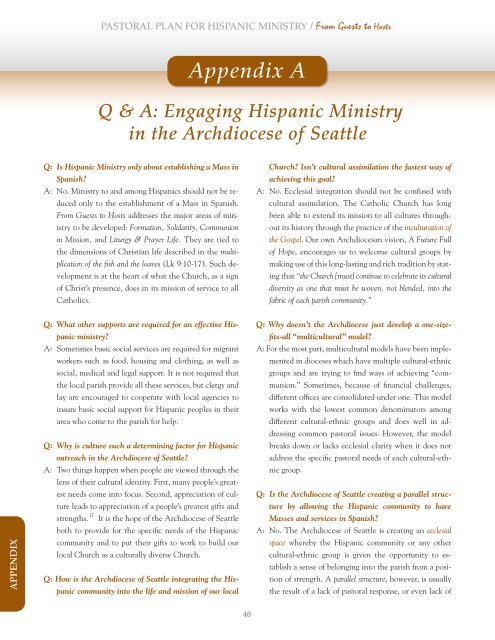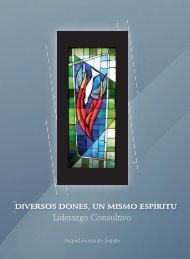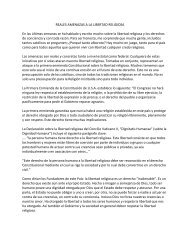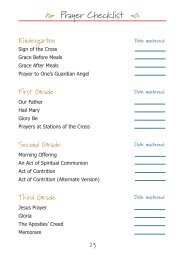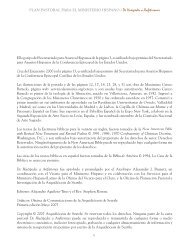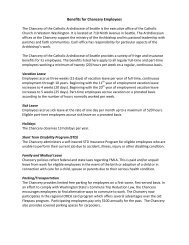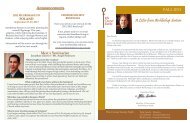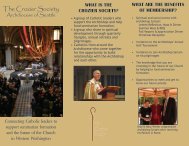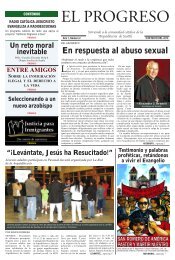Pastoral Plan for HisPanic Ministry / From Guests to Hosts Hispanic ...
Pastoral Plan for HisPanic Ministry / From Guests to Hosts Hispanic ...
Pastoral Plan for HisPanic Ministry / From Guests to Hosts Hispanic ...
You also want an ePaper? Increase the reach of your titles
YUMPU automatically turns print PDFs into web optimized ePapers that Google loves.
<strong>Pas<strong>to</strong>ral</strong> <strong>Plan</strong> <strong>for</strong> <strong>Hispanic</strong> <strong>Ministry</strong> / <strong>From</strong> <strong>Guests</strong> <strong>to</strong> <strong>Hosts</strong>Appendix AQ & A: Engaging <strong>Hispanic</strong> <strong>Ministry</strong>in the Archdiocese of SeattleQ: Is <strong>Hispanic</strong> <strong>Ministry</strong> only about establishing a Mass inSpanish?A: No. <strong>Ministry</strong> <strong>to</strong> and among <strong>Hispanic</strong>s should not be reducedonly <strong>to</strong> the establishment of a Mass in Spanish.<strong>From</strong> <strong>Guests</strong> <strong>to</strong> <strong>Hosts</strong> addresses the major areas of ministry<strong>to</strong> be developed: Formation, Solidarity, Communionin Mission, and Liturgy & Prayer Life. They are tied <strong>to</strong>the dimensions of Christian life described in the multiplicationof the fish and the loaves (Lk 9:10-17). Such developmentis at the heart of what the Church, as a signof Christ’s presence, does in its mission of service <strong>to</strong> allCatholics.Church? Isn’t cultural assimilation the fastest way ofachieving this goal?A: No. Ecclesial integration should not be confused withcultural assimilation. The Catholic Church has longbeen able <strong>to</strong> extend its mission <strong>to</strong> all cultures throughoutits his<strong>to</strong>ry through the practice of the inculturation ofthe Gospel. Our own Archdiocesan vision, A Future Fullof Hope, encourages us <strong>to</strong> welcome cultural groups bymaking use of this long-lasting and rich tradition by statingthat “the Church [must] continue <strong>to</strong> celebrate its culturaldiversity as one that must be woven, not blended, in<strong>to</strong> thefabric of each parish community.”AppendixQ: What other supports are required <strong>for</strong> an effective <strong>Hispanic</strong>ministry?A: Sometimes basic social services are required <strong>for</strong> migrantworkers such as food, housing and clothing, as well associal, medical and legal support. It is not required thatthe local parish provide all these services, but clergy andlay are encouraged <strong>to</strong> cooperate with local agencies <strong>to</strong>insure basic social support <strong>for</strong> <strong>Hispanic</strong> peoples in theirarea who come <strong>to</strong> the parish <strong>for</strong> help.Q: Why is culture such a determining fac<strong>to</strong>r <strong>for</strong> <strong>Hispanic</strong>outreach in the Archdiocese of Seattle?A: Two things happen when people are viewed through thelens of their cultural identity. First, many people’s greatestneeds come in<strong>to</strong> focus. Second, appreciation of cultureleads <strong>to</strong> appreciation of a people’s greatest gifts andstrengths. 17 It is the hope of the Archdiocese of Seattleboth <strong>to</strong> provide <strong>for</strong> the specific needs of the <strong>Hispanic</strong>community and <strong>to</strong> put their gifts <strong>to</strong> work <strong>to</strong> build ourlocal Church as a culturally diverse Church.Q: How is the Archdiocese of Seattle integrating the <strong>Hispanic</strong>community in<strong>to</strong> the life and mission of our localQ: Why doesn’t the Archdiocese just develop a one-sizefits-all“multicultural” model?A: For the most part, multicultural models have been implementedin dioceses which have multiple cultural-ethnicgroups and are trying <strong>to</strong> find ways of achieving “communion.”Sometimes, because of financial challenges,different offices are consolidated under one. This modelworks with the lowest common denomina<strong>to</strong>rs amongdifferent cultural-ethnic groups and does well in addressingcommon pas<strong>to</strong>ral issues. However, the modelbreaks down or lacks ecclesial clarity when it does notaddress the specific pas<strong>to</strong>ral needs of each cultural-ethnicgroup.Q: Is the Archdiocese of Seattle creating a parallel structureby allowing the <strong>Hispanic</strong> community <strong>to</strong> haveMasses and services in Spanish?A: No. The Archdiocese of Seattle is creating an ecclesialspace whereby the <strong>Hispanic</strong> community or any othercultural-ethnic group is given the opportunity <strong>to</strong> establisha sense of belonging in<strong>to</strong> the parish from a positionof strength. A parallel structure, however, is usuallythe result of a lack of pas<strong>to</strong>ral response, or even lack of40


